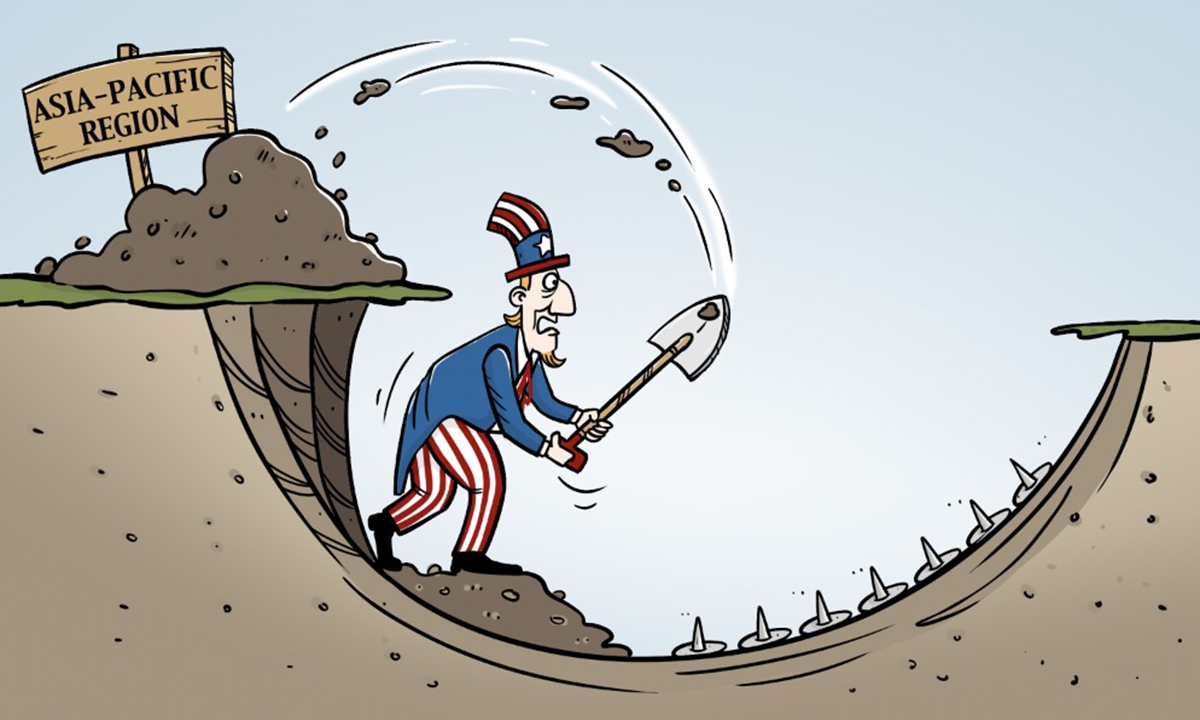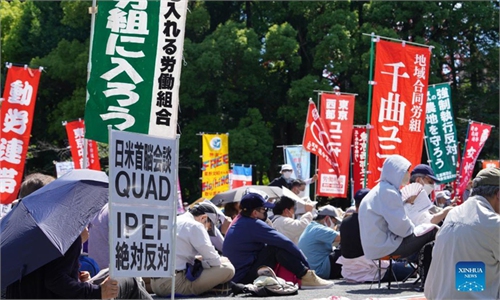
Illustration: Chen Xia/GT
First, Biden aimed to solidify the US-centered Asia-Pacific alliance system and enhance US' control over regional affairs.
In terms of South Korea, the Biden administration took the opportunity of the East Asian country's recently concluded presidential election to strengthen the US-South Korea alliance and to try and lure Seoul to stray away from its diplomacy of balancing relations with great powers.
In Japan, the Biden administration stated its support for Tokyo to become a permanent member of the United Nations Security Council and reaffirmed its security commitment to Japan, intending to further strengthen strategic ties between the two countries. The two countries further emphasized the strategic significance of mechanisms like AUKUS and the Quad.
This indicates that the US is connecting its "mini-multilateral" cooperation mechanisms. Washington stands as the axis of its alliance system, aiming to completely control its allies and the overall situation.
Second, the US is trying to shift the strategic pressure of the Russia-Ukraine conflict on China through the Taiwan question. Although the conflict between Russia and Ukraine remains the most urgent security issue for the West, the Biden administration still considers China as its biggest strategic competitor. Washington will not slow down the pace of implementing its Indo-Pacific Strategy because of Russia, nor will it weaken its containment and suppression of China. Asia remains the US' greatest geostrategic concern.
Third, the US is grasping the monopoly over key technology to manipulate the industrial supply chain, with the IPEF to establish "small yard, high fence" in Asia. Biden visited Samsung's chip plant as soon as he arrived in South Korea, demonstrating a strong willingness to build an alliance in the chip and other supply chains, as well as to monopolize and manipulate the digital supply chains in the region. The IPEF not only offers economic elements to the US Indo-Pacific Strategy, but also highlights the US intention to rebuild its own dominant trade order in the Asia-Pacific region.
The Biden administration intends to use the "small yard, high fence" to impose a technology blockade on China, and spares no effort to build a global supply chain alliance. By tightening the alliance system and launching the IPEF, the US hopes to accelerate the construction of supply chain alliances in the Asia-Pacific and guide the relocation of industrial chains to other countries in this region other than China, so as to achieve the dominance of regional technology and trade in the digital economy.
US' actions aim to maintain and consolidate its hegemony in the Asia-Pacific, but in fact set a "new cold war" trap for the region. As the US policies are centered on the competition between major powers, it naturally forces regional countries to "take sides" which creates new cracks in the cooperation of this region. The US alliance in the Asia-Pacific is a "Cold War legacy," and a series of security problems in this region left over from the Cold War era are the trigger for renewed confrontation between major powers. By hyping the "China threat" and strengthening the alliance, the US could be able to start a new cold war, and plunge the region into bloc confrontation.
With the Russia-Ukraine conflict, the US has bound Europe strategically with it, and an iron curtain of Cold War is falling in Eurasia. In order to impose further sanctions against Russia, the US is trying to promote the bloc confrontation to Asia, which is undoubtedly a dangerous signal for the Asia-Pacific. The IPEF, in name of promoting regional "freedom and openness," aims at pulling allies to engage in scientific and technological monopoly, and building a US-centered exclusive economic parallel system in Asia, which will probably lead to a new cold war.
It is often said that the 21st century is the century of Asia. However, a new cold war trap carefully set up by the US is bringing Asia to a new strategic crossroads. Once falling into the trap, Asia will lose the long-term prosperity and stability seen in the first two decades of the 21st century and become the frontier and main battlefield of confrontation between major powers. The security problems left over from the Cold War will be a new powder keg of war. How to get away from this trap and prevent the "century of Asia" from turning into a "tragedy of Asia?" A new concept of security beyond cold war thinking, and a new security practice beyond zero-sum games are both needed. This is a test for all countries in the Asia-Pacific region.
The author is Assistant Research Fellow of the Institute of American Studies, China Institutes of Contemporary International Relations.



